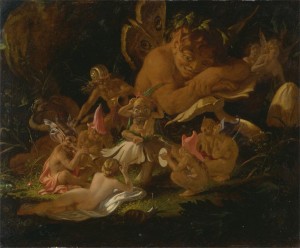Secluded from the developed world, the depths of the forest expose mankind’s greatest desires and fears. For Lysander and Hermia, the sheer distance from the Athenian law transforms the dark and wild journey to one of love and hope. Even as Hermia awakes in the night, startled at the thought of a serpent choking her in her sleep, her first shout goes towards Lysander, the one she expects and believes will be her constant. Despite its dangers, the woods provide the only privacy for the couple and for that, they are grateful. Helena, on the other hand, enters the forest desperate for even the slightest affection from Demetrius, her previous ex-fiancé. Above all, she fears the worst – that Demetrius will never love her again. The heart-broken youth is unable to sway the mind of her love and falls into the cold, damp floor of the woods. The isolated, pathless forest reflects Helena’s desperation.
Still, for some, the cold, isolated wilderness is home. Titania, upon falling madly in love with the donkey-headed Bottom, begs him to stay in the forest where the sweetest fruit and the most beautiful sights are found. In the spritely presence of Puck and the fairies, the Shakespearean wood in “A Midsummer Night’s Dream” is magical, mystical, and endless in possibilities. Location is key, and this is absolutely the place for spirits to run free, fairies to mess up their master’s orders, and the love triangle to top all love triangles.

The visual representation of the forest above entitled “Puck and Fairies from ‘A Midsummer Night’s Dream’” by Joseph Noel Paton (1821-1901) predicts the humorous tale through the animated expressions on the fairies’ faces. I admit that these are not the comical faces I pictured when I was reading the play, but it certainly puts the events into perspective. Puck, who I assume is the largest of them all, has a relaxed expression and looks calmly on as he discusses the dispute between the group’s masters. The forest is evidently “home” for these creatures, and despite the calm expression, Puck is the sly mastermind of the forest pranks. What I appreciate most of this painting is the combination of natural and spiritual factors. The grass and the greens are lifelike and a realistic snail looks on with interest as the creatures hold their casual meeting, and the spotlight only falls on the gathered group, alluding to the nightfall and darkness of the forest beyond its magic.
The small, Benjamin Button like fairy on top of a mushroom sports a look of pure horror as he dons a pointed hat and it’s quite evident that the entire fairy population present at the party is wonderfully clownish. While the woods are centered primarily around the mishap of the potion and the lively fight between lovers, I cannot help but to picture this malleable location as the everyday home of the creatures highlighted in this picture. When careless Athenian youth are not gracing the forest, the wooded playground belongs to the spirits who reside in its nooks and crannies. And while for some, the events within are but dream, for others, it’s a constant reality.
Puck and Fairies from “A Midsummer Night’s Dream.” Joseph Noel Paton. ca. 1850. ARTstor [online]. Yale Center for British Art. [cited 7 July 2015]. http://library.artstor.org/library/secure/ViewImages?id=8CladTYuJCxdLS04eTh8QHsmVQ%3D%3D&userId=hzZCcjIm&zoomparams=
